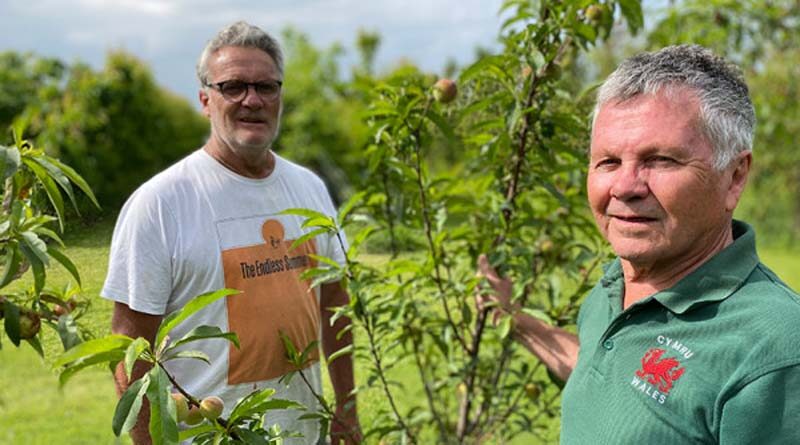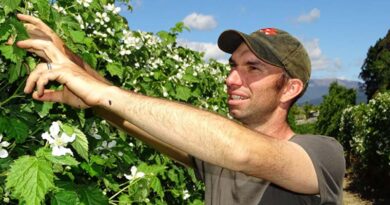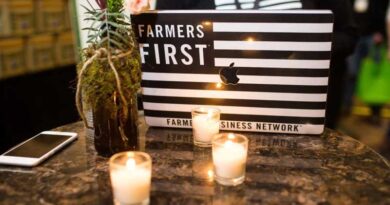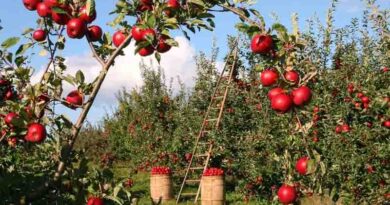Family traditions continue at historic Gisborne orchard
A Gisborne orchard with a family connection going back more than 100 years changed hands in July, but former owner Geoff Meade says while the family name has changed, its heart remains.
21 December, New Zealand: “We went out to celebrate the sale and to see the new owners’ enthusiasm, and the way they interacted and had fun together,” Geoff says. We knew we had made the right decision and these were the right people.”
Geoff’s own connection to Bruce Estate dates back to 1920 when the original settler family, the U’rens, sold the property to John McMillan, grandfather of Geoff’s former wife, Kath Jones (née McMillan).
The Estate was then passed on to Kath’s parents, Bruce and Melba, who established the two-hectare property just out of Gisborne as a successful vineyard.
In 1978, Geoff and Kath took over to allow Bruce and Melba to retire and indulge their love of travel. A year later, Geoff, a teacher, was out on a field trip with students while Kath and their one-year-old daughter, Kirsten, headed west to Auckland to collect her parents, who were due back from their trip of a lifetime.
Then they received the worst news imaginable: Bruce and Melba’s flight – Air New Zealand Flight TE901 – had gone missing over Antarctica and was eventually confirmed to have crashed into Mount Erebus, killing all 237 passengers and 20 crew on board.
“It was the worst of times, the most horrible of times, and of course, even worse for Kath,” Geoff says. “That was why we named the orchard Bruce Estate and that is where I put most of my energy over the next few years.”
Also Read: Various interventions and schemes launched for the benefit of Indian farmers
Although the orchard was passed down from the McMillan family, it was really Geoff’s passion. So, when the couple parted ways, Kath opted to sell her half to Geoff’s colleague, Richard Ludlow, and his wife Diane.
“Kath remains a wonderful friend,” says Geoff.
“At the time we were harvesting grapes for Cook’s Wines, but it was a fairly low-value crop and then the grapes got phylloxera [a grapevine pest]. We ripped them out in 1985, just a year before the government paid growers to do that.”
Richard and Geoff decided to replant with 1,000 nashi (Asian pear) trees, the glamour crop of the mid-1980s that, though in its infancy, was making big inroads into the export market.
“Being in Gisborne, we found they didn’t travel well, so we’d grown this beautiful fruit which by the time it got to market, was ruined,” says Geoff.
“Rather than start again we decided to stick with the nashi but focus on selling locally and that’s what we’ve done ever since.”
A decade after the Erebus tragedy, Geoff remarried – his wife Raewyn bringing two more children into the family – and in 1993 they bought out the Ludlows to take full ownership of the orchard.
Over the following years they combined working their day jobs (Geoff retrained as a career consultant) with tending to the orchard and further developing their local market.
Some of the nashi did get sacrificed and that, along with the removal of some excess shelter belts, made way for plantings of Amredark nectarines, Spring Crest and Spring Lady peaches, a variety of plums (including Fortune, Black Doris, Omega/George Wilson, Angelino, Santa Rosa and Luisa), with a few feijoas (Kaiteri, Kakariki and Anatoki) to boot.
That, says Geoff, made for a nicely staggered harvest – the peaches and nectarines coming on before Christmas, followed by the nashi in February and the various plums spread throughout.
While we had some of the best soil (Waihirere silt loam) and climate conditions in the world, Gisborne can still present challenges for stonefruit. With no netting and a gentle spray programme, we just had to accept some losses to the birds and bugs,” Geoff says.
“Raewyn comes from an orcharding family, the Forges, who also have 100 years of history in orcharding. So, she’s a quality controller par excellence and that’s why we always put out such beautiful, award-winning fruit.”
After more than 40 years on the orchard and countless days operating gate sales and the Gisborne Farmers’ Market, Geoff decided it was time to retire.
“The orchard was always a healing place for me, from the grief of losing Kath’s parents to the intensity of working with young people who are facing some really big life challenges,” he says.
“It’s been really special to keep the line going through our children to our beautiful grandchildren, who have a fifth-generation connection to the orchard, so it was pretty hard to make the decision to sell.”
But it’s not over yet. Geoff is still a regular visitor to the now-renamed Bruce Estate and is sharing on-orchard practices with the new owners.
“You get a real feel for the land, a real feel for the trees,” he says. “We are more than happy to pass on what we have learned for a new family to take into their future.”
Shelley and Chris Hunt and family are the proud new owners of the orchard, which they will use to supply their fresh fruit ice cream shop, Village Berries.
For more than a decade the shop has provided holiday jobs to many students, including the Hunts’ four children and now it has its own orchard with Chris on board as orchard manager.
The duo initially bought a fresh fruit ice cream shop to support their university children with summer jobs so they could pay their way.
More than a decade on, Shelley is now sole owner of Gisborne’s Village Berries. The shop has provided holiday jobs to many students and now that it has its own orchard, they can set up a circular supply system and stock their own produce.
Having bought the former Bruce Estate – two hectares at Ormond, just out of Gisborne city – Village Berries has installed dad, Chris, as orchard manager.
“We [are] both really a couple of townies but Chris has a history in viticulture and has always been a great gardener,” laughs Village Berries matriarch, Shelley.
“In any case, former orchard owner, Geoff Meade, is always on hand to offer his experience and advice.”
As the primary shareholder in Village Berries, Shelley has over the last 11 years been hands-on, juggling the demands of the business with her nearly 40-year career as a health and physical education teacher.
She’s soon to have her last day in the classroom as she pivots to focus on bringing the shop and the orchard together.
But she won’t be on her own. As well as having Chris work the land, son-in-law, Tom McCann, manages the shop while son, Dougal Hunt, does the heavy lifting at the store. The rest of Team Hunt – daughters Harriet Anderson and Madeline McCann, son Jack and their respective partners – are also on call to help out when required.
“I’m certainly not retiring, it’s more of a change of careers,” Shelley says. “I loved working in education and still do, but something had to give and that was it.”
Although the orchard has been renamed as Village Berry Orchard, its history and crops remain, with the Hunts inheriting the Meades’ mixed plantings dominated by nashi, with supplementary crops of nectarines, peaches, plums, and feijoas.
And yes, that does mean that Black Doris ice creams will soon be on the menu at Village Berries.
“We’ll likely take out some nashi so we can experiment with things like bramble berries,” Shelley says.
We see it as a ‘tutti-frutti’ orchard, rather than one offering a single main product. We’re keen to start small and see what works so we’ll be learning along the way.
As it stands, Village Berries has already evolved from a summer ice cream and berry shop to one that operates year-round, selling a limited range of prepared foods as well as fruit and vegetables.
Growing their own gives them the opportunity to sell nashi through a local marketer and packhouse, keep the shop stocked with fresh produce and set up at the Gisborne Farmers’ Market to offer any overflow.
“We’ve always made a point of getting to know our growers personally and working with people who grow ethically on smaller holdings,” Shelley says.
“Making the supply chain even more transparent by growing our own means customers know exactly where their produce is coming from and can join us on our journey as we develop and experiment over the years to come.”















